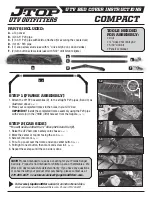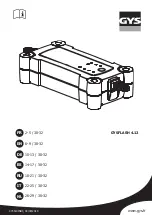
ELECTRONIC BRAKE
CONTROL SYSTEM
Your vehicle is equipped with an advanced elec-
tronic brake control system that includes the
Anti-Lock Brake System (ABS), Traction Control
System (TCS), Brake Assist System (BAS), Elec-
tronic Roll Mitigation (ERM), and Electronic Sta-
bility Control (ESC). All five of these systems work
together to enhance vehicle stability and control in
various driving conditions.
Also, your vehicle is equipped with Trailer Sway
Control (TSC), Hill Start Assist (HSA), Brake
Lock Differential (BLD), Ready Alert Braking,
Rain Brake Support and, if it has four-wheel
drive with the MP 3023 two-speed transfer
case, Hill Descent Control (HDC).
Anti-Lock Brake System (ABS)
This system aids the driver in maintaining ve-
hicle control under adverse braking conditions.
The system controls hydraulic brake pressure
to prevent wheel lock-up and help avoid skid-
ding on slippery surfaces during braking. Refer
to “Anti-Lock Brake System” in “Starting and
Operating” for further information.
WARNING!
The ABS cannot prevent the natural laws of
physics from acting on the vehicle, nor can it
increase the traction afforded by prevailing
road conditions. The ABS cannot prevent
collisions, including those resulting from ex-
cessive speed in turns, driving on very slip-
pery surfaces, or hydroplaning. The capabili-
ties of an ABS-equipped vehicle must never
be exploited in a reckless or dangerous
manner which could jeopardize the user’s
safety or the safety of others.
Traction Control System (TCS)
This system monitors the amount of wheel spin
of each of the driven wheels. If wheel spin is
detected, brake pressure is applied to the slip-
ping wheel(s) and engine power is reduced to
provide enhanced acceleration and stability.
A feature of the TCS system, Brake Limited
Differential (BLD), functions similar to a limited-
slip differential and controls the wheel spin
across a driven axle. If one wheel on a driven
axle is spinning faster than the other, the sys-
tem will apply the brake of the spinning wheel.
This will allow more engine torque to be applied
to the wheel that is not spinning. This feature
remains active even if ESC system is in the
“Partial Off” mode. Refer to “Electronic Stability
Control (ESC)” in this section for further infor-
mation.
Brake Assist System (BAS)
The BAS is designed to optimize the vehicle’s
braking capability during emergency braking
maneuvers. The system detects an emergency
braking situation by sensing the rate and
amount of brake application and then applies
optimum pressure to the brakes. This can help
reduce braking distances. The BAS comple-
ments the anti-lock brake system (ABS). Apply-
ing the brakes very quickly results in the best
BAS assistance. To receive the benefit of the
system, you must apply continuous braking
pressure during the stopping sequence (do not
“pump” the brakes). Do not reduce brake pedal
pressure unless braking is no longer desired.
Once the brake pedal is released, the BAS is
deactivated.
252
Summary of Contents for 2013 Grand Cherokee
Page 1: ...Grand Cherokee O P E R AT I N G I N F O R M AT I O N...
Page 2: ......
Page 3: ......
Page 4: ......
Page 6: ...2...
Page 11: ...7...
Page 66: ...62...
Page 91: ...87...
Page 92: ...88...
Page 93: ...89...
Page 165: ...INSTRUMENT CLUSTER 161...
Page 187: ...Compass Variance Map 183...
Page 218: ...Operating Tips Chart 214...
Page 296: ...292...
Page 372: ...368...
Page 395: ...391...
Page 396: ...392...
Page 397: ...10 INDEX 393...
Page 407: ......
Page 408: ...Chrysler Group LLC 13WK741 126 ENG AB Printed in Europe 13...
















































